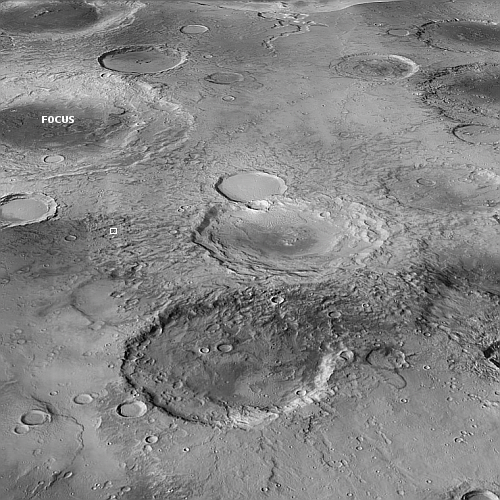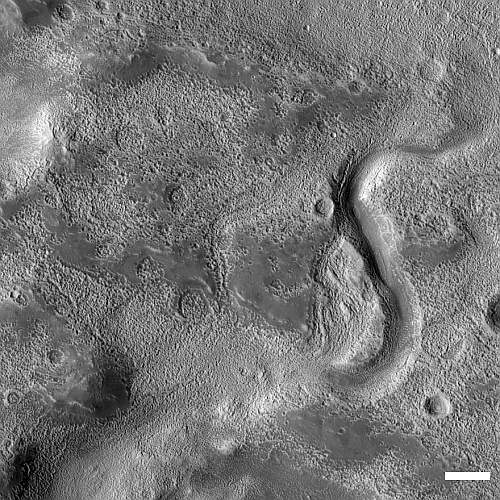The splatter surrounding a mid-latitude Martian crater
Cool image time! The picture to the right, cropped, reduced, and sharpened to post here, was taken on April 12, 2023 by the high resolution camera on Mars Reconnaissance Orbiter (MRO). It shows what the scientists simply label as “Northern Mid-latitude Terrain”.
I have focused in on that meandering channel and the landscape around it. On Earth we would assume that channel marks the drainage of a river or stream, possibly also shaped by a glacier at some point because of its U-shaped profile. This guess is strengthened by the elevation data from MRO, which shows the channel descending to the southwest about 440 feet along its 2.2 mile length.
The channel and the eroded look of the surrounding terrain suggests strongly the presence of near-surface ice at this location, which is not unreasonable based on its 32 degree north latitude. The wider look below only adds further strength to this hypothesis, but also adds a lot more details explaining the genesis of this strange landscape.


On the overview map to the right the red dot in Arabia Terra marks the location. Though significantly south of glacier country, this location is still north of 30 degrees latitude, the dividing line between Mars’ icy polar regions and its dry equatorial tropics. However, being close to 30 degrees latitude we are also in a region where the surface is beginning to dry out, and the evidence of underground ice is found farther below ground.
The second image to the right illustrates this. This image is from a global mosaic created by Murray Lab at Caltech using the entire archive of context camera images from MRO. That mosaic not only includes MRO elevation data, it shows the context camera images from an oblique angle, looking to the north.
The small white box in the center left marks the approximate area covered by the first picture above, on the western flanks of an unnamed 25-mile wide crater. The wide apron around that crater gives it a splattered look, not unlike many craters found in the much more icy northern lowland plains. At the same time, many of the other craters nearby do not have that splattered look, and instead appear as if their impact had occurred when the ground was either dryer, or any near surface ice was deeper underground.
The channel as well as the eroded terrain around it form part of that splatter, and suggest we are looking at the aftermath of that impact, when the underground ice here was quickly melted by the heat of impact as well as excavated upwards to the surface. The ice probably ran both as liquid water for a short time in the channel, and then froze into a glacier that carved its way downhill. In later eons the ice in the channel as well as the ice on the plateau above sublimated away, leaving this rough eroded landscape.
At least that’s my uneducated theory. I gladly invite better educated geologists to correct me and provide us all a better theory.
On Christmas Eve 1968 three Americans became the first humans to visit another world. What they did to celebrate was unexpected and profound, and will be remembered throughout all human history. Genesis: the Story of Apollo 8, Robert Zimmerman's classic history of humanity's first journey to another world, tells that story, and it is now available as both an ebook and an audiobook, both with a foreword by Valerie Anders and a new introduction by Robert Zimmerman.
The print edition can be purchased at Amazon or from any other book seller. If you want an autographed copy the price is $60 for the hardback and $45 for the paperback, plus $8 shipping for each. Go here for purchasing details. The ebook is available everywhere for $5.99 (before discount) at amazon, or direct from my ebook publisher, ebookit. If you buy it from ebookit you don't support the big tech companies and the author gets a bigger cut much sooner.
The audiobook is also available at all these vendors, and is also free with a 30-day trial membership to Audible.
"Not simply about one mission, [Genesis] is also the history of America's quest for the moon... Zimmerman has done a masterful job of tying disparate events together into a solid account of one of America's greatest human triumphs."--San Antonio Express-News
Cool image time! The picture to the right, cropped, reduced, and sharpened to post here, was taken on April 12, 2023 by the high resolution camera on Mars Reconnaissance Orbiter (MRO). It shows what the scientists simply label as “Northern Mid-latitude Terrain”.
I have focused in on that meandering channel and the landscape around it. On Earth we would assume that channel marks the drainage of a river or stream, possibly also shaped by a glacier at some point because of its U-shaped profile. This guess is strengthened by the elevation data from MRO, which shows the channel descending to the southwest about 440 feet along its 2.2 mile length.
The channel and the eroded look of the surrounding terrain suggests strongly the presence of near-surface ice at this location, which is not unreasonable based on its 32 degree north latitude. The wider look below only adds further strength to this hypothesis, but also adds a lot more details explaining the genesis of this strange landscape.


On the overview map to the right the red dot in Arabia Terra marks the location. Though significantly south of glacier country, this location is still north of 30 degrees latitude, the dividing line between Mars’ icy polar regions and its dry equatorial tropics. However, being close to 30 degrees latitude we are also in a region where the surface is beginning to dry out, and the evidence of underground ice is found farther below ground.
The second image to the right illustrates this. This image is from a global mosaic created by Murray Lab at Caltech using the entire archive of context camera images from MRO. That mosaic not only includes MRO elevation data, it shows the context camera images from an oblique angle, looking to the north.
The small white box in the center left marks the approximate area covered by the first picture above, on the western flanks of an unnamed 25-mile wide crater. The wide apron around that crater gives it a splattered look, not unlike many craters found in the much more icy northern lowland plains. At the same time, many of the other craters nearby do not have that splattered look, and instead appear as if their impact had occurred when the ground was either dryer, or any near surface ice was deeper underground.
The channel as well as the eroded terrain around it form part of that splatter, and suggest we are looking at the aftermath of that impact, when the underground ice here was quickly melted by the heat of impact as well as excavated upwards to the surface. The ice probably ran both as liquid water for a short time in the channel, and then froze into a glacier that carved its way downhill. In later eons the ice in the channel as well as the ice on the plateau above sublimated away, leaving this rough eroded landscape.
At least that’s my uneducated theory. I gladly invite better educated geologists to correct me and provide us all a better theory.
On Christmas Eve 1968 three Americans became the first humans to visit another world. What they did to celebrate was unexpected and profound, and will be remembered throughout all human history. Genesis: the Story of Apollo 8, Robert Zimmerman's classic history of humanity's first journey to another world, tells that story, and it is now available as both an ebook and an audiobook, both with a foreword by Valerie Anders and a new introduction by Robert Zimmerman.
The print edition can be purchased at Amazon or from any other book seller. If you want an autographed copy the price is $60 for the hardback and $45 for the paperback, plus $8 shipping for each. Go here for purchasing details. The ebook is available everywhere for $5.99 (before discount) at amazon, or direct from my ebook publisher, ebookit. If you buy it from ebookit you don't support the big tech companies and the author gets a bigger cut much sooner.
The audiobook is also available at all these vendors, and is also free with a 30-day trial membership to Audible.
"Not simply about one mission, [Genesis] is also the history of America's quest for the moon... Zimmerman has done a masterful job of tying disparate events together into a solid account of one of America's greatest human triumphs."--San Antonio Express-News


